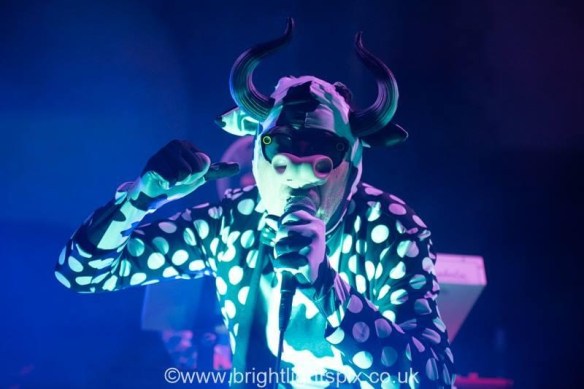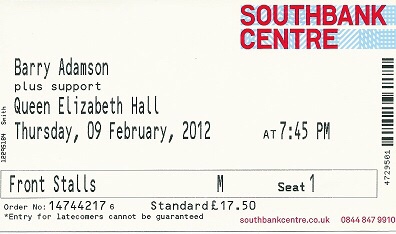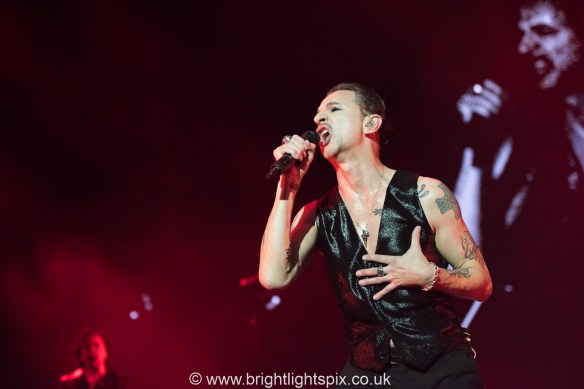
It’s a bright, early Bay Area morning and Homer Flynn, the official spokesperson of The Residents, is sat in front of what looks like a monochrome vortex, a swirling pattern full of motion like a Bridget Riley painting infused with psychedelic properties. It has the effect of disorienting you, distracting you, and you feel yourself being drawn into its invisible centre. At its centre is Flynn and The Residents, a world of secrets, obfuscation, obscurity, myths and experimentation, and, like the gravitational pull of a black hole – or the arcana of The Residents – it’s impossible to resist.
The vortex is not designed to confuse or prompt speculation, or even evoke the colour scheme of The Residents’ infamous black tux / white shirt eyeball head era. It is mostly for practical purposes: Flynn, like the rest of the world, has been forced to spend lockdown communicating by video calls, and he’d gotten fed up of the boring backdrop of his office wall that he could see behind him whenever he connected to a call. “You know, I’m a visual guy,” he says in an accent rich with his Louisiana origins. Flynn is not only the spokesperson for the band, but also their principal designer, usually attributing his work as Pornographics, though it is rarely spelled the same way twice. He is both laconic and earnest, carrying a business-like efficiency but exuding a friendly warmth that might be best described as Southern hospitality, a trait that cuts through the impersonality of a Skype call.
“I thought I should have something more interesting behind me,” he continues, gesturing at the mesmerising spiral. “The Residents recently did a performance of their God In Three Persons album at the Museum Of Modern Art in New York. I did a lot of artwork for that, and I used various iterations of these weird spirals a lot in the artwork, so it seemed like it would be nice. It’s actually a piece of cloth. It’s a big piece of cloth that’s tacked up on the wall.”
Though it’s off-camera, Flynn is surrounded by The Residents’ rich archive. He indicates that there are filing cabinets in his office containing letters, documents and other artefacts, while his attic contains yet more. One day these will each be pored over and scrutinised in an attempt to make sense of this enduring group of artistic conceptualists, a unit whose anonymity has somehow – mostly, intentionally – been preserved, from their initial experiments in the 1960s to today.
It is the time of those early, tentative breaths of The Residents’ existence that is the focus of Metal, Meat & Bone – The Songs Of Dyin’ Dog. A collection of blues songs originally recorded in the early 1970s by a singer that only The Residents appear to have heard of, this is an album that returns them, metaphorically, to Louisiana from whence they made their journey to California in 1965.
—

The Residents, St. George’s Church, Kemp Town, Brighton February 7 2019. Photo (c) Brightlightspix
The Residents formed in Shreveport, Louisiana, so the story goes, in the early 1960s. Shreveport was founded the century before as a strategic trading town on the passage between the important Red River commercial waterway and Texas, a territory hewn forcibly from Mexico. The later discovery of rich stores of oil made Shreveport the centre of a modern-day goldrush as the big oil producing firms moved in, creating one of Louisiana’s mostly economically valuable and socially thriving locations.
The group of high school friends and musical auteurs that became known, serendipitously, as The Residents opted to follow the route of the original goldrush, initially decamping to San Mateo thanks to their truck breaking down, and then finally completing the extra twenty miles to San Francisco itself (which had been their destination all along) about seven years later. Where their ancestors might have been drawn to the Bay Area to pan for gold and make (and often squander) their fortunes, The Residents were drawn there for its free and easy lifestyle. This was the time of Beats, hippies, Kerouac, Ginsberg, the City Lights Bookstore, free love and the counter-culture; a city that was On The Road, yet squarely, and wilfully, off the grid.
One of the first people The Residents worked with, back in Shreveport, was fellow musician Roland Sheehan. “He was friends with The Residents, and was involved with them in the beginning when they first started experimenting,” explains Flynn. “He actually spent a summer with The Residents – I think it was maybe the summer of 1970 or something like that. When he drove from Louisiana to the Bay Area, he brought a lot of musical instruments with him. It was these instruments that The Residents started recording and experimenting with, and so he claims this territory of being there at the very beginning of the band.” The band reconnected with Sheehan after decades of not being in touch while making The Theory Of Obscurity, a 2015 documentary about The Residents.
Sheehan had performed in a local Dubach, Louisiana group called The Alliance, managed by departed Resident Hardy Fox. In fact, The Alliance’s garage rock cover of Simon & Garfunkel’s ‘Somewhere They Can’t Find Me’ features four individuals on its sleeve who, if you were minded to squint, could be the future Residents sans eyeballs. Or just four guys. Or maybe Sheehan didn’t just make a roadtrip to meet up with his old buddies in 1970 but stayed on in San Mateo. Or maybe these are just the sorts of thoughts that go through your mind with The Residents where everything feels like it might be part of a grand artistic conspiracy. Either way, Sheehan was part of The Residents’ early story.
“After he’d spent that summer with The Residents, Roland went back to Louisiana,” continues Flynn. “He got involved with a local albino blues musician called Alvin Snow who performed under the name Dyin’ Dog, and Roland put a band together for him.” The nascent band cut some demos, which sat, unreleased and mostly forgotten about in Louisiana.
The story of Alvin Snow is the stuff that blues legends are made from. Abandoned by his parents, Snow was left for dead on the steps of a Mississipi orphanage, mercifully receiving the benefaction of a kindly group of nuns. From the off, the young Snow was an outsider, and in adolescence fell into drugs, crime – and music. He wound up in a Louisiana town where a kindly old lady, a certain Ms Lillian Underwood, took him under her wing and nurtured his nascent talent as a blues singer; later, a chance encounter on the street with the youthful Roland Sheehan led the talented, yet challenged, Snow to a local recording studio whereupon Sheehan and the studio’s owner gave him the Dyin’ Dog moniker. A showcase gig was booked at a local Dubach theatre, the Gem, for Snow’s 37th birthday in 1976 but by the date of the concert he’d mysteriously vanished, never to be heard from again.
The Residents themselves were drawn to the blues, despite their early experiments sounding nothing like that, being fashioned from tapeloops and a borderless approach to sonic technique. “The Residents grew up in blues territory, and always had a great affinity for it,” asserts Flynn on behalf of the band. “They were big fans of Bo Diddley, you know, even though he was more crossover, really, but he came from a blues tradition – he was one of the ones who took blues into rock ‘n’ roll. The Residents were also big Howlin’ Wolf fans. They just really appreciated the form, especially as it evolved from blues to R&B. It was music that they always wanted to explore, but just never got around to.” Anecdotally, Flynn says that there are many, many ideas that The Residents come up with, but that only a tiny fraction of those actually ever materialise. Given that they have released somewhere in the region of 75 albums, we think, the idea of all those notions that didn’t get recorded is staggering.
Despite a mutual connection in the form of Sheehan, none of The Residents came across Alvin Snow while they were in Louisiana. All attempts to Google him seem to return you to The Residents, making this a sort of meta-mystery in the story of the band, and leading you to pore over the pictures of Snow in the booklet for Metal, Meat & Bone to see if they’re faked. And then, just like with The Residents’ own story, you shrug, accept that it’s best to just accept that you’ll never know the complete truth about anything to do with the band, and enjoy the story, even though it does mean – in my case – that you might be asking questions that simply add to the story’s dubious legitimacy, almost like you’re the one creating the trail on The Residents’ behalf.
“Alvin was kind of the mysterious type,” says Flynn. “He eventually just disappeared, but Roland still had these demos. Roland had a conversation with one of The Residents, who still had this interest in doing a blues project, and Roland thought, ‘Well, you know, maybe I have something that might be interesting to them.’ When he mentioned it to them, he dismissed it. You know, it was a bunch of demos from the 1970s – who cares? But, at the same time, he ended up bringing them in, and playing them for The Residents, and they loved them. The whole project took off from that point.”

The Residents Present Alvin Snow aka Dyin’ Dog (2019). Any likeness to a famous James Dean photograph is purely coincidental.
Before recording Metal, Meat & Bone, the band issued the demos as a highly limited five 7-inch single box set on Germany’s Psychofon imprint in 2019. It looked and felt like a time capsule, the discs presented as large-centre singles with scrappy labels, the only concession to modernity being the coloured vinyl some editions of the demos were pressed on. Those raw Alvin Snow demos now form the second disc of Metal, Meat & Bone, rounded out by other demos that Sheehan discovered while rooting though the Gem Theatre in Dubach.
The first disc finds The Residents interpreting those original Alvin Snow demos, as well as adding extra tracks inspired by Dyin’ Dog’s music. The result is uniquely recognisable as the band, with churning electronics and an angry, almost confrontational edge. Guitars splinter and crack with commanding, stentorian energy and the songs are thrust into a sort of sinewy industrial post-modernism. You hear the distinctive sound of the blues but it is recast as a distinctly modern artform, mostly fronted with feisty, blistering power by The Singing Resident. (The Singing Resident has been known as Tyrone since 2017; prior to that he was known as Randy Rose, Roger ‘Bunny’ Hartley, Mr. Skull, Seymore Hodges, Mr. Red Eye, and The Enigmatic Foe; some have noted the similarities between The Singing Resident’s voice and that of Homer Flynn’s.) Elsewhere on the album are quieter, more reflective moments, sung in a harrowing, affecting style by an uncredited female vocalist, full of bleak drama and visceral narrative.
“The Residents have always enjoyed reinterpreting other music,” explains Flynn. “They’ve always enjoyed exploring other forms, but somehow they always come out Residential. They don’t come out like they started.” I comment on how well the electronic elements seem to suit blues songs, even though they maybe shouldn’t fit together so easily. “Well that’s good,” says Flynn in response. “That’s certainly what we like to hear. They wanted to see if they could make that work.” This is the business-like, third-person voice of Flynn, spokesperson for the band and de facto head of the Cryptic Corporation, the organisation that oversees The Residents’ various activities.
Typical of The Residents, Metal, Meat & Bone finds the group working with some of their coterie of collaborators, easily identifiable by having, for the most part, actual identities: Nolan Cook, Carla Fabrizio, Sivan Lioncub, Peter Whitehead and Rob Laufer. Added to the list of likeminded friends and relations for the album is Pixies’ Frank Black, himself a user of an identity-disguising pseudonym in the form of Black Francis. Black adds his distinctive, angry preacher voice to one of the album’s many highlights, the emphatic ‘Die! Die! Die!’.
I ask Flynn how it’s possible that The Residents manage to attract so many collaborators considering their reputation for being somehow inaccessible. Is it the case that people who share their weltanschauung just seem to gravitate toward them? “Well, actually I think that’s more the case,” he says. “Most of The Residents’ collaborations come about kind of organically, one way or another.
“The connection to Frank Black came through Eric Drew Feldman,” he continues. “Eric is the prime producer with The Residents at this point – he’s really the architect of their sound. He has a longstanding relationship with Frank and he played with The Pixies on tour. It was right at the very beginning of the recording of the album, and they were looking for one or more guest people to come and do things, and as fate would have it, The Pixies played in San Francisco. They just happened to be in town. And so Eric got in touch with Frank and said, ‘Hey, do you want to do a vocal on The Residents’ album?’ And he said, ‘Yeah, sure, that sounds like fun.’ So, it really came about through Eric’s relationship with Frank. Frank did a fantastic job – he did a great job with that song.”
It is easy to break apart The Residents’ back catalogue into two convenient halves – the wildly experimental side wherein technology plays a huge role, and then the more song-based, story-telling side. In a way, Metal, Meat & Bone follows on from George & James (1984) and Stars & Hank Forever! (1986). On those albums, The Residents were recreating – in their own, inscrutable way – the music of George Gershwin, James Brown, the American folk music of Hank Williams and the marching band music of John Philip Sousa. These records were intended to form a series that would explore the American music tradition. Those two albums turned out to be the only albums in that series, suggesting that this became one of the ideas Flynn talked about that never got completed properly, or they enjoyed the idea of raising (and then thwarting) expectations. While they could have maybe gone about their interest in the blues through a straight reinterpretation of one of the artists whose music they admired, like they did on The American Composer’s Series, instead they opted for a different route, telling the story of an essentially unknown – or possibly unknowable – musician. And after all, who would want The Residents to do what you expect of them?

The Residents – Stars & Hank Forever! – The American Composer’s Series Volume II (1986)
—
Years ago, Flynn was interviewed as one of the talking heads (talking eyes?) in The Eyes Scream, a 1991 pseudo-documentary and promo video best-of. He was featured alongside the departed Hardy Fox, later unmasked as Chuck Bobuck from The Residents’ Randy, Chuck and Bob phase upon his passing in 2018. In his interview, Flynn talks about the band’s constant efforts at “creating their own reality”.
Flynn returns to that notion as we finish our conversation about Metal, Meat & Bone. “At their core, in a way, I think The Residents are storytellers,” he says. “They love having a narrative to spin something around. Sometimes the narrative is more inherent, in the content, and sometimes the narrative is the container that the content goes into.
“Sometimes it’s a bit of both. And, with Metal, Meat & Bone, I think that’s definitely the case,” he concludes, leaning back in his office chair with a smile.
My eye is once again drawn to that swirling vortex behind him; it is a place of tall stories, semi-mythical characters, wonky, filtered versions of the truth and the weird, wonderfully indefinable – and continually fluctuating – centre of this enduring band’s idiosyncratic universe.

The Residents, St. George’s Church, Kemp Town, Brighton February 7 2019. Photo (c) Brightlightspix
Metal, Meat & Bone – The Songs Of Dyin’ Dog by The Residents is released July 10 2020 by MVD / Cherry Red.
With thanks to Matt and Andy.
Interview: Mat Smith.
Photos: Andy Sturmey (Brightlightspix)
Text (c) 2020 Documentary Evidence // Photos (c) 2019 Andy Sturmey



































